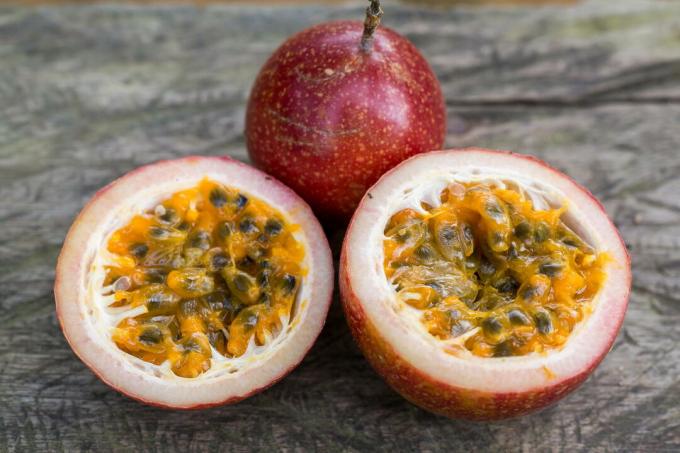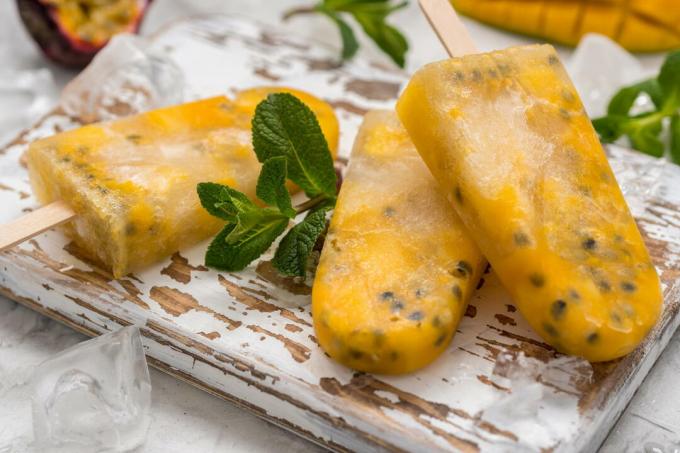The passion flower is not only an ornamental plant, it also bears fruit. Here you can find out everything about harvesting and using the healthy passion fruit.

The fruit of the Passion flower (Passiflora) is of course called passion fruit, but it is also known under the name granadille, especially in South America. This name is derived from the Spanish word "granadilla", which means something like "small pomegranate". Indeed, the appearance of the fruit is reminiscent of a pomegranate.
contents
- Passion fruit
- Passion fruit: ingredients and vitamins
- Harvesting passion fruit: when is it ripe?
- Store passion fruit correctly
- Eating and preparing passion fruit properly
Passion fruit
There are innumerable types of passion fruit and with this diversity of species it is not surprising that some passion flowers produce edible fruit while others do not. But which are now edible? Basically it should be said that the fruits of most inedible species are not poisonous, just not tasty. Even so, there are poisonous species that are better not to try. These include passion flowers of the subgenus
Decaloba. These are usually identified by leaves with a white pattern. On the other hand, the yellow fruits of the passion fruit (Passiflora edulis forma flavicarpa) and the purple to lilac colored fruits of the purple granadilla (Passiflora edulis forma edulis). These two are of great economic importance worldwide and are also available from us in stores. The adjective "edulis" also means "edible". Also not to be underestimated are the fruits of the flesh-colored passion flower (Passiflora incarnata) and the sweet granadilla (Passiflora ligularis). The blue passion flower, often kept as an ornamental plant (Passiflora caerolea) unfortunately does not bear any fruit that is worth recommending, but at least it does not bear any poisonous fruit.Passion fruit: ingredients and vitamins
The passion fruit has it all. It is not exactly rich in calories, because with 64 kilocalories per 100 grams it is more of a light weight, but it has other ingredients. The fruits are rich in vitamin C and the two B vitamins riboflavin and niacin. Enjoying a ripe passion fruit thus boosts your immune system and your metabolism. Minerals are also abundant in the fruit. Particularly noteworthy is the rather high phosphorus content of 57 milligrams per 100 grams of pulp. Phosphate is important for bones and teeth and plays an important role in the production of energy in the body. The high proportion of potassium, which maintains cell functions, and iron, which is required for the production of blood and muscle cells, should also not go unmentioned. The passion fruit clearly deserves the title of healthy fruit.

Harvesting passion fruit: when is it ripe?
If your passion flower has a good location and is allowed outside in summer, the chances are not bad that it will bear fruit. However, these can only ripen during a long summer or if you move your passion flower to a greenhouse or winter garden in autumn. But when are the fruits ripe? This can be recognized primarily by the color. Unripe fruits are still green and should not be eaten. If the skin is red to dark purple, the fruit is ripe. However, passion fruit fruits ripen in yellow tones.
Store passion fruit correctly
If you don't want to eat your passion fruit straight away, it is best to put it in the refrigerator. At low temperatures, the fruit will keep for about one to a maximum of three weeks. If your passion fruit is not yet fully ripe, store the fruit at room temperature for a few days before consuming it. Passion fruits are climacteric, so they can still ripen after the harvest. However, this happens more quickly at room temperature. If you want it to be particularly quick, simply place an apple nearby. These give off ethylene, which accelerates the ripening process.
Eating and preparing passion fruit properly
There are innumerable small seeds in passion fruit that are surrounded by pulp. These are rich in unsaturated fatty acids and can be eaten with confidence. If you are less fond of pips, it is advisable to press the fruit mass through a sieve before consumption. If you want to enjoy the passion fruit fresh, it is best to cut it open with a cross section and spoon it out. You should avoid the white skin. With some types of passion fruit, you can also remove the hard shell at the upper end by hand, make a small hole in the white skin underneath and suck out the contents of the fruit. The passion fruit can be easily consumed while traveling without getting your hands dirty. Of course there are also many delicious recipes and it is worth trying them out.

The kernels surrounded by the pulp are very tasty in a fresh summer salad, for example. The meat of the passion fruit is also suitable in muesli or yoghurt as well as to refine a dessert or as a sorbet. The pitted fruit mass can also be mixed into dry cakes or muffins to achieve a fruity note. The herb of the passion flower is not directly suitable for consumption, but it plays an important role in naturopathy. Find out more about passionflower herb here.
By the way: Maracujas are a subspecies of passion fruit and are characterized by a yellow skin and a slightly sour taste.
